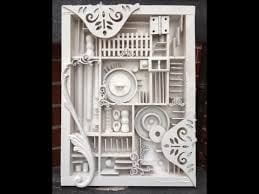Assemblage is a form of sculpture comprised of “found” objects arranged in such a way that they create a complete art work. Basically assemblage is three dimensional collage. The objects can be anything organic or human-made. Scraps of wood, stones, old shoes, baked bean cans and a discarded baby buggy – or any of the other 84,000,000 items not here mentioned by name – all qualify for inclusion in an assemblage. Whatever catches the artist’s eye, and fits properly in the composition to make a unified whole, is fair game. Objects can be glued, nailed, tied, woven or joined together in what ever way holds them.
.Some history about assemblage: Before the Dada Art movement at the beginning of the 1900’s artists were only considered to be artists if they painted, drew, or sculpted realistically. Other kinds of artmaking and other ideas about art content were not considered to be “Art”. Thank goodness for the Dada movement that “freed” art from such a narrow view of what is art. Dada introduced the collage and the assemblage as another way of making art. Remember, Dada artists said that art is about unique and creative idea making, not about painting realistically.
Pablo Picasso got interested in Art in the early 1900’s, and he followed the Dada movement. He made some assemblage constructions, starting in 1912. An early example is his Still Life 1914 which is made from scraps of wood and a length of tablecloth fringing, glued together and painted. Picasso continued to use assemblage intermittently throughout his career.
The “Assemblage” -Louise Nevelson
The Queen of Assemblage, however, was Louise Nevelson. Louise was a courageous artist who became popular for making assemblages instead of following conventional ways of making art.
Please watch this short, informative video about Louise and her art designs:
Your Assemblage assignment:
You need to create an assemblage out of materials that you can collect. The recycling bin is an excellent source for assemblage material, however it is not the only source. Old jewelery or machine parts such as bicycle gears or bolts and wood scraps, old toys and toy parts, and hardware from the garage or junk drawer in your condo are all great places to scrounge for assemblage material. If you can find or create a box to assemble them is that might be helpful. Or assemble them on a piece of cardboard (a side of a cereal box).
You need to glue, wire, tie, or nail together the various objects so that they are connected and will not separate. Your sculpture is not a unified sculpture if it is not connected together.
Have a look at these two videos for an idea for how to approach this challenge::
Your assemblage needs to be 3D.
It can be made to view from the front, like Louise Nevelson’s: 
This is called a “RELIEF” sculpture when it is only viewed from the front. Relief sculptures are generally hung on a wall. They are still “3D” because they have a lot of “ups and downs” or depth in the front to back.
If you have paint at home, and the desire, you can choose to paint your relief sculpture all one colour, so that the shapes and textures and patterns of the work are the main focus::
Or you can leave the objects in your sculpture unpainted. If you choose to do this then you need to also consider the colours in the objects as you assemble them into a unified composition. Don’t let the colours confuse the arrangement or create chaos.
Or You can choose to make an “in the round” assemblage instead of a relief one:
In the round sculptures are designed to be viewed from all directions. They are generally displayed on a table or floor.
Your assemblage HAS TO BE ABSTRACT. This is because you need to focus your artistic eye on the composition.
- Make the entire work look good as a unified whole artwork.
- Work to create a repeating pattern in it somewhere
- Work to create various textures in it.
- Connect or attach all the pieces into one assembled unit. No loose, separate pieces are allowed.
- Concentrate on the shapes of the objects that you use and how, when you put them together, they interact with each other.
- Create some interesting NEGATIVE SPACES (the space between) the objects.
- When you move across the sculpture, or around it, it should change its appearance as your position changes.
- If you can paint the work when you are finished, great. If you don’t have any paint, then consider how it looks unpainted.
Your sculpture needs to be completed by Thursday, June 11. Please email me one photo of the relief sculpture or a few photos of your assemblage sculpture if it is in the round.
We will meet on Teams again next week June 11 at 11:40. See you then.
There will be one more Found Object Art assignment.
The final day for submitting any Art work for this course is June 18.




